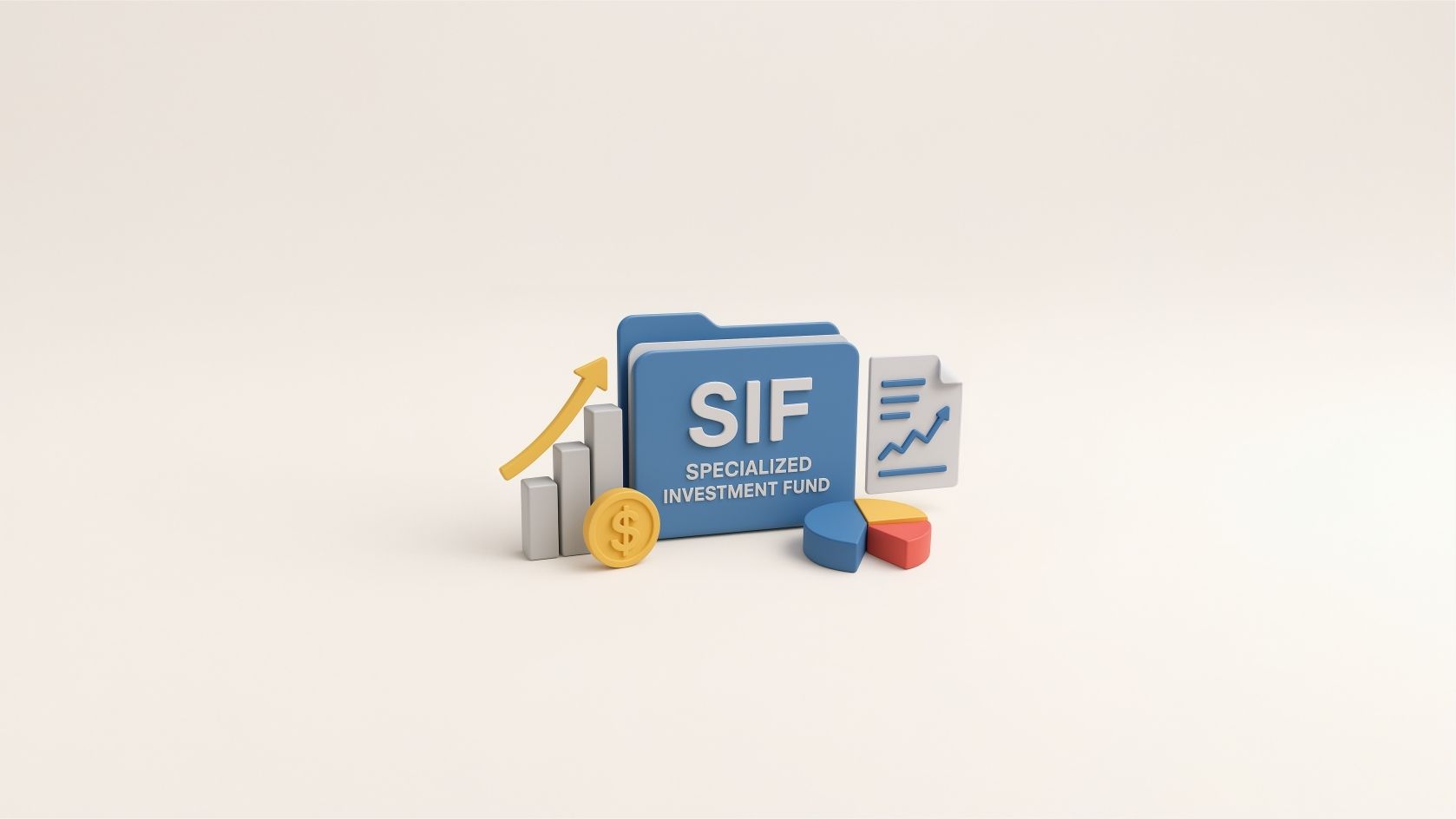- Home
- Blog
- Mutual Funds
- SIF (Specialised Investment Fund): What’s New In It?
- SIF (Specialised Investment Fund): What’s New In It?
SIF (Specialised Investment Fund): What’s New In It?

- Published Date: October 27, 2025
- Updated Date: October 27, 2025
- By Team Choice
SIF (Specialised Investment Fund) is a new category of investment that was introduced by SEBI in April 2025 that bridged the gap between traditional investments like mutual funds (MFs) and portfolio management service (PMS) and alternative investment funds (AIF). SIF is designed such that it allows AMCs (asset management companies) to use sophisticated investment strategies with dynamic asset allocation, sectoral rotation, and flexibility to use complex long-short strategies in derivatives.
Key Notes For Investors
- Investor looking for a dynamic and sophisticated investment strategy.
- Minimum investment amount per Pan card: Rs.10 lakhs in SIFs under one AMC. This will exclude mutual fund investment in that AMC. Unless the investor is an accredited investor.
- SIFs can be equity-oriented, debt-oriented, or hybrid strategies according to their investment approach.
- SIFs can also use complex investment strategies such as long-short equity strategy, sectoral rotation long-short, debt long-short, hybrid strategy, etc.
- SIFs can take 25% of their net asset value in naked positions in derivatives other than hedging, depending upon the fund manager's strategy. Unlike other traditional investment options, this strategy can generate returns for investors in upward and downward markets as well.
- It can be a more risky and rewarding investment option compared to mutual funds due to its exposure to derivatives.
- It is highly transparent and regulated by SEBI.
-AMCs can provide the option of a Systematic Investment Plan (SIP), Systematic Withdrawal Plan (SWP), and Systematic Transfer Plan (STP) in SIFs as long as it follows the minimum investment threshold.
How do SIFs work?
SEBI allows an AMC to launch a scheme in 3 categories of strategy.
- Equity-oriented investment strategy
- Debt-oriented investment strategy
- Hybrid investment strategy
Each consists of subtypes explained further. Each type of fund can take 25% of its asset value in a naked derivative position other than hedging and the other in cash or securities. It can take a derivative position only in the type of security the fund is dealing in. Each scheme is structured as an open-ended or interval investing strategy. Minimum redemption frequency rules given by SEBI for each type of fund are explained further. It provides lump-sum, SIP, SWP, and STP options.
Types of SIF Funds
Equity-oriented investment strategies
1) Equity Long-Short Fund
Minimum 80% in equities and equity-related products, including REITs and InvITs.
Maximum 25% of AUM in an unhedged derivative position in equity.
Structure: Open-ended/interval fund investment
Redemption Frequency: Daily or less
2) Equity Ex-Top 100 Long-Short Fund
Minimum 65% investment in equities excluding the top 100 companies by market cap.
Maximum 25% of AUM in unhedged derivative positions in equity products, excluding large-cap stocks
Structure: Open-ended/Interval fund
Redemption Frequency: Daily or less
3) Sector Rotation Long-Short Fund:
Minimum 80% in equities and equity-related products, and it can consist of a maximum of 4 sectors.
A maximum of 25% of AUM in an unhedged derivative position in an equity product, a position in the respective sector of security holding.
Structure: Open-ended/Interval investment
Redemption Frequency: Daily or less
Debt-oriented investment strategies
1) Debt Long-Short Fund
Investment in debt instruments across different durations.
Unhedged derivative position in exchange-traded debt derivatives
Structure: Interval investment
Redemption Frequency: Once a week or less as per AMCs
2) Sectoral Long-Short Fund
Investment in debt instruments of a minimum of 2 sectors with a maximum limit of 75% investment in one sector.
Maximum naked derivative position of 25% in debt instruments of that sector held in the portfolio.
Structure: Interval investment
Redemption frequency: Once a week or less
Hybrid investment strategies
1) Active Asset Allocator Long-Short:
Dynamic investment allocation in different asset classes such as equity, debt, equity & debt derivatives, REITs, InViTs, and commodity derivatives.
Maximum 25% unhedged derivative position in equity and debt derivatives.
Structure: Interval investment
Redemption frequency: Two times in a week or less
2) Hybrid Long-Short Fund
Minimum 25% investment in equity-related instruments.
Minimum 25% investment in debt instruments.
Maximum 25% unhedged derivative position in equity and debt.
Structure: Interval investment.
Redemption frequency: Two times a week or less.
The following types of schemes are designed by SEBI for AMCs to launch; each one of the funds is designed for investors of different types.
Comparison: SIF/MF/PMS/AIF
| Feature | SIF (Special Investment Fund) | MF (Mutual Fund) | PMS (Portfolio Management Service) | AIF (Alternative Investment Fund) |
|---|---|---|---|---|
| Target Investors | Affluent HNIs seeking advanced yet tax-efficient strategies | First-time to long-term retail/HNI investors | HNIs wanting personalized portfolios | Ultra-HNIs & institutions exploring non-traditional assets |
| Nomenclature | Investment Strategy | Scheme | Portfolio | Fund |
| Minimum Investment | ₹10 lakh | ₹100 (SIP & lump sum) | ₹50 lakh | ₹1 crore |
| Structure | Hybrid between MF & PMS/AIF; MF-like taxation | Pooled, SEBI-regulated vehicle | Separately managed, direct stock ownership | Pooled, privately placed schemes |
| Strategies | Flexible: long-short, dynamic asset allocation, derivatives allowed | Equity, debt, hybrid, index-based | Customizable: thematic, concentrated, sectoral | Private equity, VC, hedge, real estate, special situations |
| Taxation at Investor Level | LTCG 12.5% (Equity/Other); Debt – slab | Same as SIF | Taxed per transaction | Pass-through (varies by category) |
| Taxation at Fund Level | Nil (Sec 10 (23D)) | Nil (Sec 10 (23D)) | Nil | Cat III: Capital gains @12.5% + Business Income @ MMR |
| Derivatives | Naked shorts up to 25% + hedging | Only for hedging | Only for hedging | Allowed |
| Liquidity | Moderate (depends on strategy) | High (open-ended schemes) | Moderate (exit load/notice period) | Low (typically closed-ended) |
Conclusion
SIF has arrived at a sweet spot in terms of minimum investment compared to PMS/AIF and with the sophistication of investment. The maximum limit of naked positions in derivatives and the minimum requirement of securities in a portfolio make the products' risk-reward attractive for sophisticated investors. Its option to go short on markets through derivatives can make it gain in a downward market trend. It is broadly for investors looking for diversification on investment products with higher risk-reward in a lesser ticket size.
Recommended for you

Copper Price Forecast for Next Week

Indian Stock Market Prediction For Next Week

Fundamental Trading: Meaning, Strategies, Tools & Best Practices
